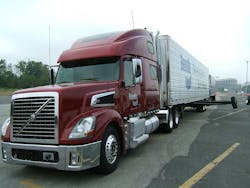Manager: T.J. Thomas
Title: Director of marketing & customer solutions
Company: Bendix Commercial Vehicle Systems
Operation: Test fleet of 30 power units and 30 pieces of towable equipment from dollies to flatbeds, dry vans and tanker trailers
Problem:
From the perspective of commercial vehicle engineers, T.J. Thomas will tell you that the words testing and evaluation represent two very different philosophies when it comes to preparing technology for the real world.
“When we talk about testing, we’re talking about pushing the boundaries of what a particular technology is capable of; going to the extremes, if you will,” he says.
That’s why Bendix relies on its own test vehicle fleet, which it operates on closed courses.
“But evaluation is a very different practice,” Thomas stresses. “When we provide technology to customers—like our electronic stability program (ESP)—and ask them to evaluate it, that means running it in a normal operating environment and seeing if drivers and technicians notice anything out of the ordinary occurring.”
He says Bendix is often focused on finding maintenance-related issues that might affect the system’s overall performance, especially in the case of evaluations for ESP.
“For us, it all comes down to drivability,” Thomas explains. “It’s very, very important that we get the driver to agree with us that ESP should be on the vehicle.”
Solution:
Based on its test fleet and customer evaluation data, Bendix noted that maintenance of the sensor array controlling its ESP technology, also generically known as electronic stability control (ESC), is critical.
“It uses a number of sensors to address a tractor’s roll and directional stability as well as measuring driver intent and vehicle direction,” Thomas notes. “The sensors and controls at the heart of an ESC system require little or no routine maintenance. Drivers and technicians should familiarize themselves with the system’s service data sheets so they know where to turn for explanations of trouble codes and diagnostic tools.”
In Bendix’s case, that information is found within its ACom diagnostics software, Thomas says.
“The physical components of an ESC system typically need attention only if certain aspects of the vehicle itself have changed,” he points out. “For example, if new steering system components are installed, the front end has been altered, or the vehicle has been realigned, the ESP’s steering angle sensor will need to be recalibrated.”
Thomas stresses that this particular procedure is covered in service data sheets and supported using diagnostics software.
“Similarly, if a vehicle’s tire size changes, the ESP will need to be updated with the new tire values through its diagnostic support software,” he adds. The specific stability system maker or vehicle manufacturer should be consulted in the case of more significant modifications such as changing the wheel base or installing or moving an axle, he emphasizes.
ESC is also a key component with collision mitigation technology like the Bendix Wingman system, he adds.
“Our Wingman package is built on the foundation of ESC,” Thomas explains. “This type of system uses a radar sensor mounted to the front of the vehicle to deliver both warnings and active interventions that can help drivers potentially avoid rear-end collisions, or at least help reduce their severity.”
Yet to function properly, the radar needs a clear view of the road ahead. That’s why it’s important to pay close attention to the radar sensor during vehicle pretrip inspections to ensure that the system’s “field of view” is free of debris and other obstructions.
“The components of a collision mitigation system require maintenance if trouble codes are active,” Thomas notes. “If the front end of the vehicle sustains damage, follow service data sheet instructions to address possible alignment needs.”
About the Author
Sean Kilcarr
Editor in Chief
Sean Kilcarr is a former longtime FleetOwner senior editor who wrote for the publication from 2000 to 2018. He served as editor-in-chief from 2017 to 2018.
